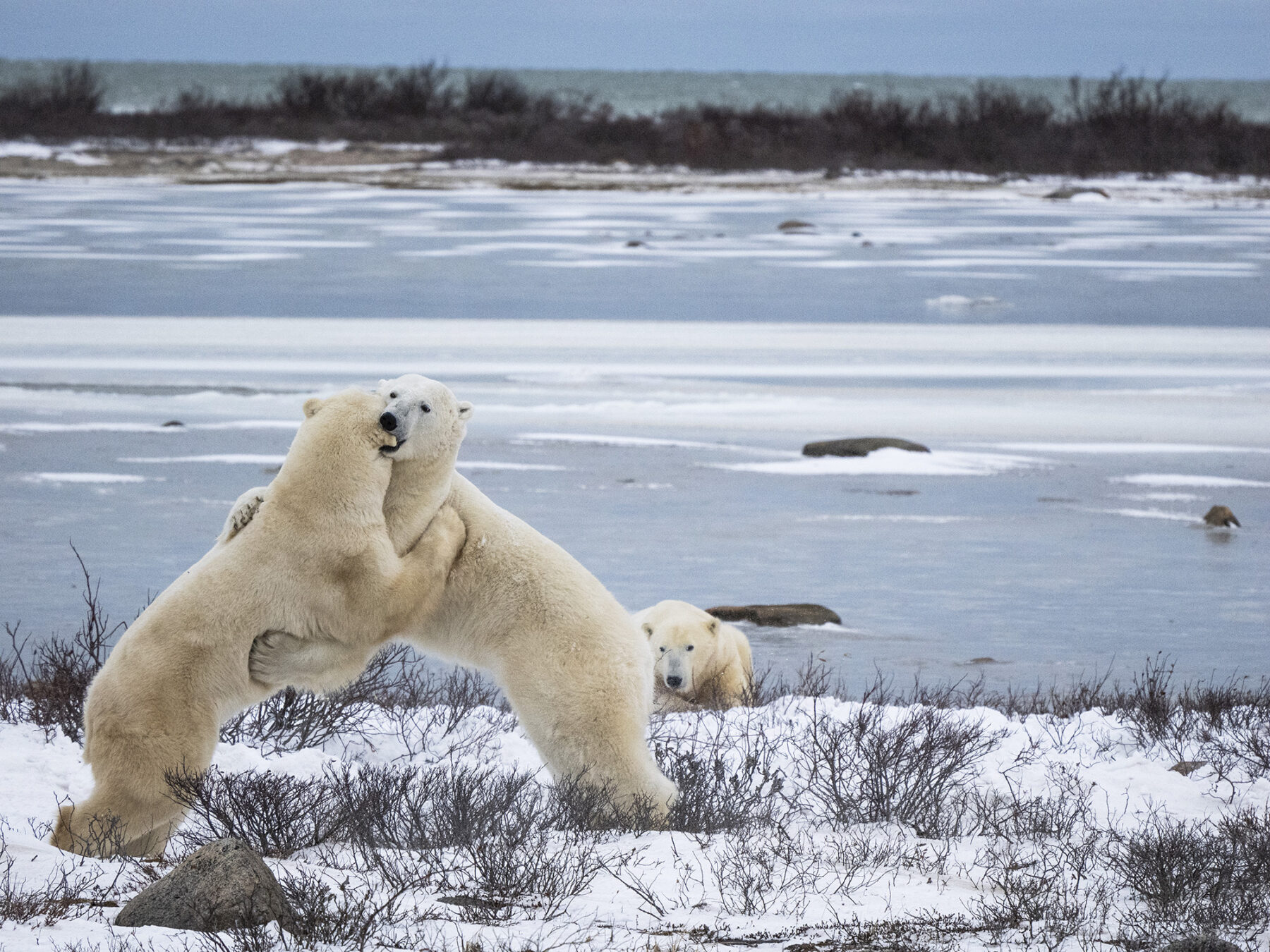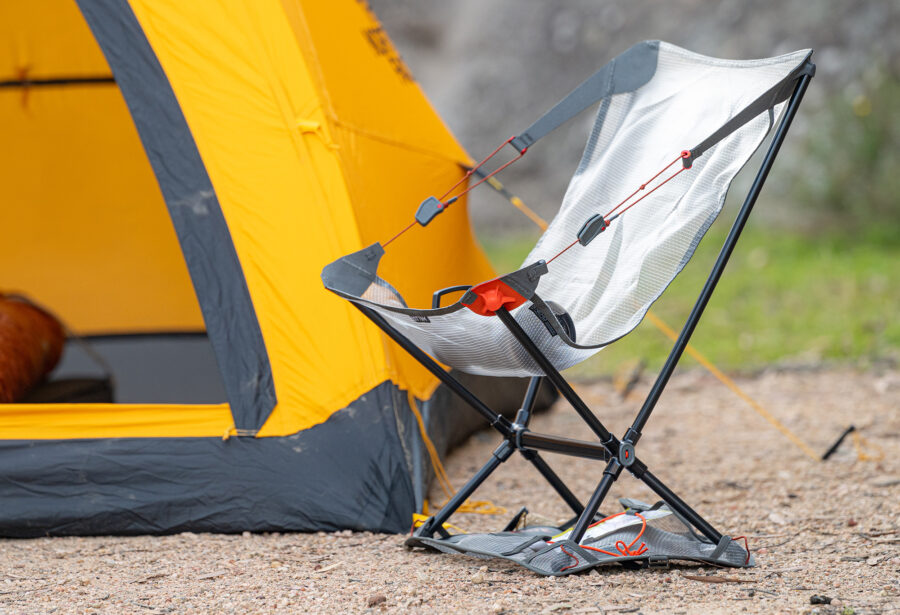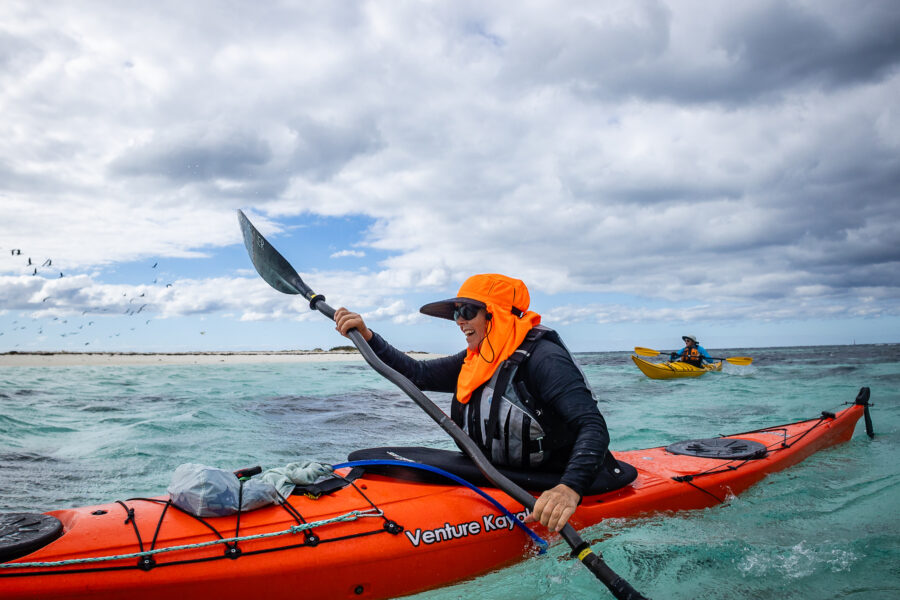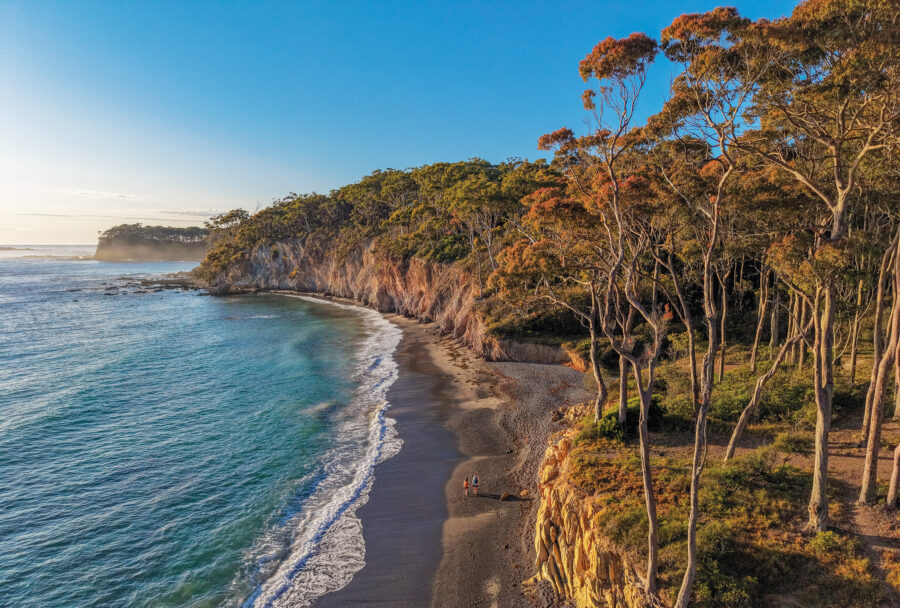She is magnificent; imposing in size, quiet – deathly quiet, in fact – and incredibly curious, the female polar bear less than a metre right below me, standing on her hind legs to get a better (read: nice and close) look at me in my high-set, safe and secure viewpoint. There’s an overwhelming sense of great awe from me and my fellow Frontiers North Adventures Tundra Buggy® occupants as we stand nearly face to face with the largest land-based predator on the planet in her arctic tundra home. On her hind legs she’s nearly as tall as our three-metre-high viewing platform.

Most of us are so awestruck, in fact, that cameras have nearly (but not quite) been forgotten. We’re fully engrossed in this unforgettable encounter; the polar bear’s quiet breath the only sound, her twitching nose the only movement as she strives to get a sensory fix on the captivated audience in front of her. We’ve just been not-so-subtly reminded that we aren’t the dominant life form in this cold, barren and faraway land. It’s a mind-blowing moment in time.
In the beginning
Few adventures start off with a flight on a privately chartered 737, but this one does. When it comes to reaching one of the world’s most isolated communities at this time of year, travel by air is the quickest (you can take the longer journey to Churchill by train, too, which would be an amazing experience in itself). So it is that two groups of Frontiers North guests, including me, board the 737 at Winnipeg (Manitoba’s capital city, and a place well worth exploring) for an early flight to the town of Churchill, roughly 1000km north.
The previous evening we’d had an introductory meet and greet, where our Frontiers North guide (and photographer) Mark Dunsmuir had filled us in on our next five days in the far north: what to expect, what to bring clothing-wise (it was going to be a tad chilly with daytime temps below zero), and the answers to plenty more of our questions. Now, it’s time to sit back, revel in my own row of seats on the 737, and start the journey to the subarctic, where the wild things are.
Living on the edge
This region has been home to, initially, the Thule people, and now the Inuit, Dene, Chipewyan and Cree peoples for millennia before the arrival of Europeans, starting from the early 1600s. Churchill itself was established in the early 1700s by the Hudson’s Bay Company during the heyday of the fur trade, and it’s nestled on the banks of its namesake river mouth on the western shores of Hudson Bay.


Churchill is the living embodiment of a frontier town, giving the term ‘isolation’ a whole new meaning – something that’s brought home to us from our airborne viewpoint high above. The dark smudge that signifies the township far below is dwarfed by the immensity of the white and brown arctic tundra landscape surrounding it, and the huge body of water that is Hudson Bay itself.
The previous evening Mark had given us the run-down on visiting Churchill – in particular, safety around the polar bears that frequently enter the town. After being welcomed by our bus driver, Mark, and clambering aboard for our first town tour, he reiterates just how important it is to be bear-aware, and why Churchill is renowned globally as ‘the polar bear capital of the world’.
The town sits smack-bang in the middle of the migratory route used by polar bears as they move on and off the frozen ice of Hudson Bay over the course of a year. In winter, the polar bears are out on the frozen bay, hunting for seals, which are their primary food source. It’s when the ice melts – around late June to early July – that the bears move back onto the shore, where they then wait for Hudson Bay to refreeze.
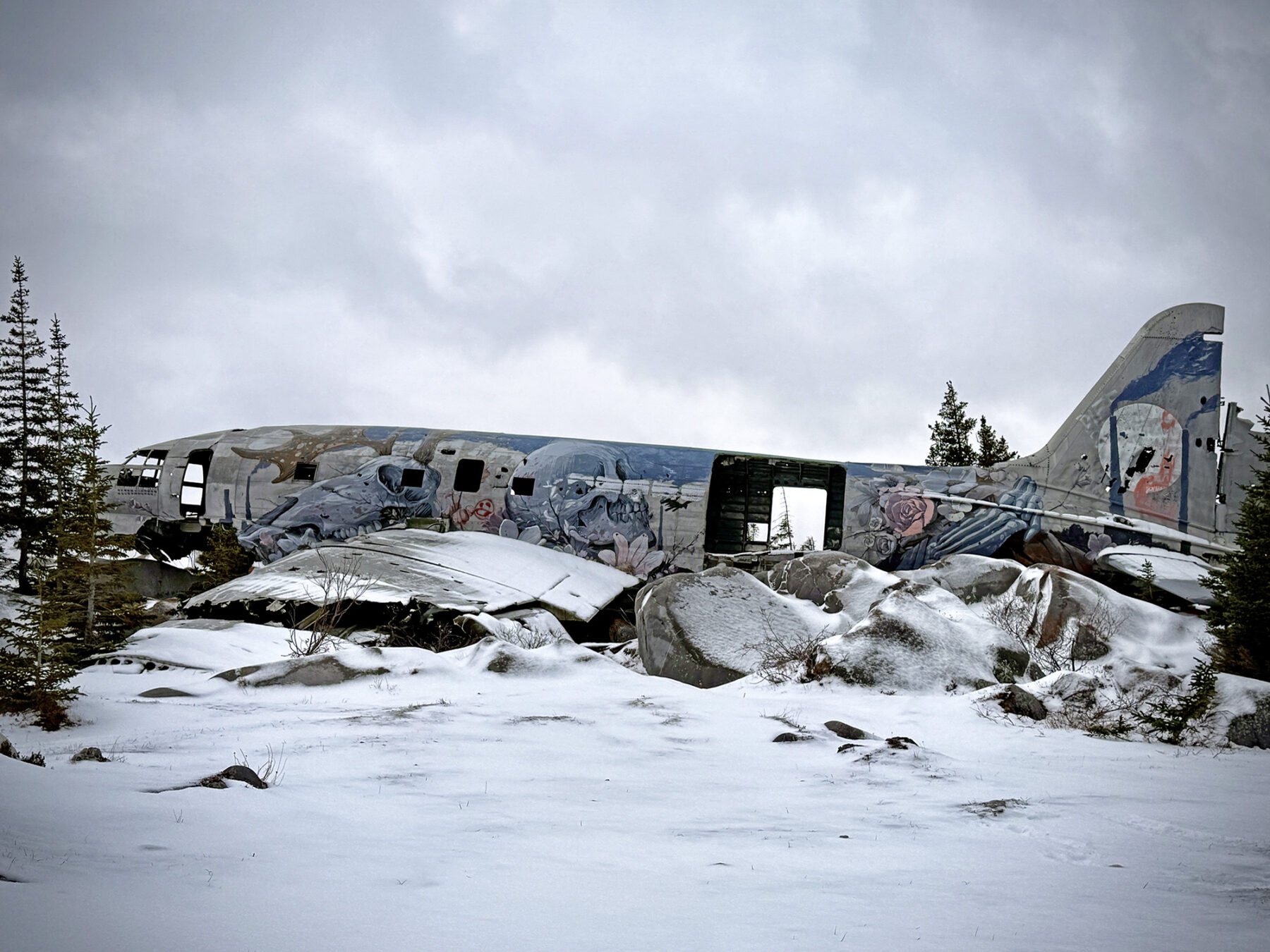
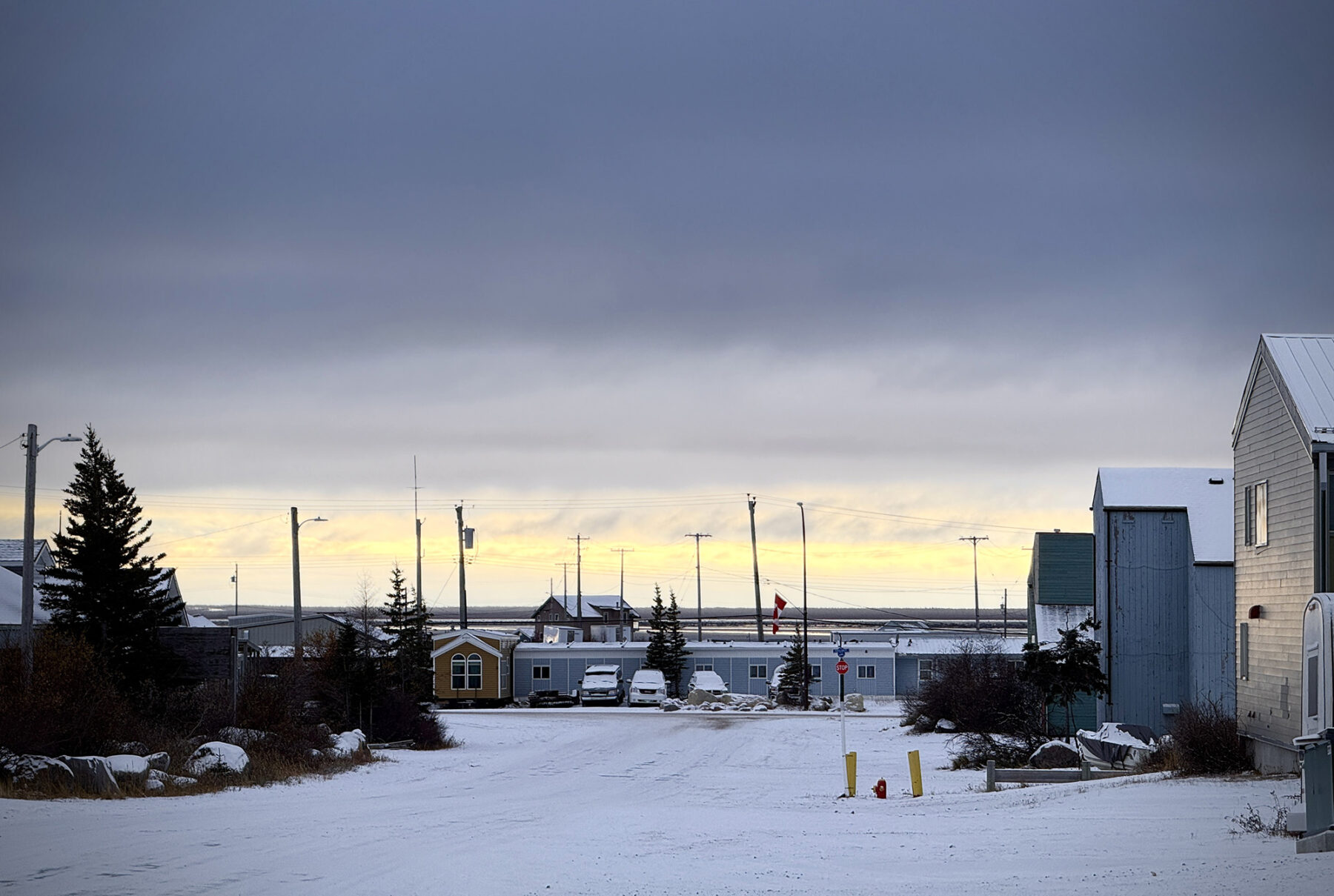
During the northern autumn the polar bears start to move back toward the coast as they wait for the impending refreeze of the bay. It’s during this time that Churchill sees the most bears in town. Not only is it part of their migratory route, but the attraction of food smells, rubbish, etc., draws them in. To help keep humans and bears apart, the town and Parks Canada created what is called the Polar Bear Alert Program in 1981, to assist in keeping the bears away from the town (and people) and ensuring that bears don’t become used to seeing the town as a source of food, through scavenging.
Mark reminds us of some key points when visiting town. Make sure we walk in groups. Don’t walk down alleyways alone. When rounding a corner of buildings, make sure we take a wide curve. Don’t walk at night. He then reminds us that polar bears belie their bulky appearance with an ability to reach 40km/h within two strides.
Another ‘unique’ feature in Churchill is that owners of vehicles and houses are encouraged to keep their doors unlocked. This means that, if you’re somehow confronted by a bear, you can move to the nearest vehicle or house knowing you can get inside, away from any danger. Add in bear patrol vehicles (and 24-hour patrols), a 10pm bear alarm in summer (to remind kids to head indoors) and excellent bear safety signage around town, and even though it sounds slightly disconcerting initially, the Polar Bear Alert Program has proven very successful in minimising bear/human confrontations and ensuring both species stay safe. To me, that’s a win.
A rich history
Our first experience of Churchill is a reminder of just how ruggedly challenging living in this region would have been in the past. We head toward the bay to check out the historic cannon battery at Cape Merry. This barren outcrop is on the ‘other side’ of the river mouth from historic Prince of Wales Fort. The battery at Cape Merry was built to provide crossfire in the event of an enemy ship trying to enter the river mouth. It’s beautiful in its barren location and surrounds. The waters of the river below are already showing signs of the upcoming freeze, and we’re again reminded of the fact bears wander around here by the sight of park rangers with shotguns posted at high viewpoints. The shotguns are loaded with what are known as ‘bear banger’ shells that, as the moniker suggests, are non-lethal shotgun shells that are fired into the air and emit a loud ‘bang’ noise to scare off the bear.
From Cape Merry, we return to town and check out the awesome Itsanitaq Museum, where we view ancient Inuit artefacts (including carvings made from whale and caribou bone, plus old hunting equipment), as well as exhibits based on the local arctic wildlife such as bears, walruses and wolves. One item that grabs my eye is the qayaq (kayak), built for a late 1950s film in the style of indigenous kayaks of that time. It’s a small museum, but it’s big in what it contains in terms of educating yourself on the region’s indigenous culture and history.


Our indigenous education continues after lunch with a cultural presentation by Florence Hamilton, a Sayisi Dene woman and Churchill resident, focused on her relearning of her people’s culture. Listening to people such as Florence, as she recounts this story, reinforces why I believe having a chance such as this – to meet and learn from those who live in regions visited by travellers – is integral in understanding the complete story of any place you visit.
Into the wild
Coffees, pastries and ourselves back on board our bus, it’s time to head out to the lodge. Funnily enough, even though it’s already been a long day with an early start, no-one looks tired. There’s a definite vibe in our group, all of us sensing we’re closer to the ‘main event’.
Before we reach Tundra Buggy Lodge, located inside the Churchill Wildlife Management Area (CWMA; abutting Wapusk National Park), we transfer from our ‘regular’ bus into an actual Tundra Buggy and meet our driver, Jim Baldwin, who has been with Frontiers North Adventures for more than 18 years. To say the Tundra Buggy is impressive is an understatement. It’s probably best described as something akin to a wide train carriage on massive 1.5-metre-tall, 20-ply tyres (designed to nearly ‘float’ over the terrain), with seating for 40 people. Our group numbers just 20, so each of us has a double seat to ourselves, which is awesome. Inside, there’s also a small bench for food/drinks, a toilet, heating (yay!) and, up the front, the driver’s seat and controls. I say “controls” because, rather than being powered by diesel, our Electric Vehicle (EV) Tundra Buggy is one of three in the fleet (with more to come) that has been converted to battery power, so the ‘throttle’ is activated via a large touchscreen. It’s the biggest EV I’ve ever seen – and impressively quiet.
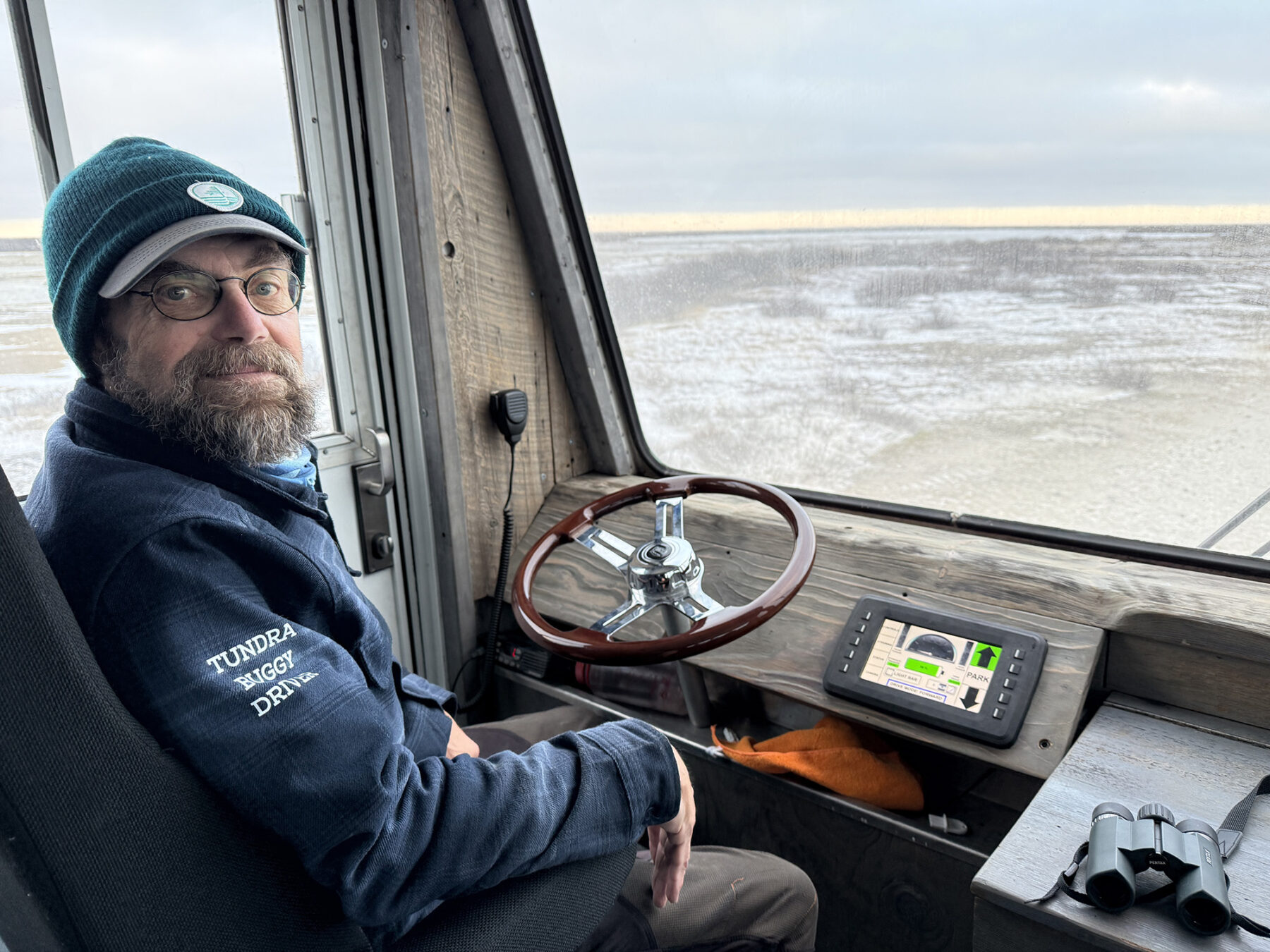
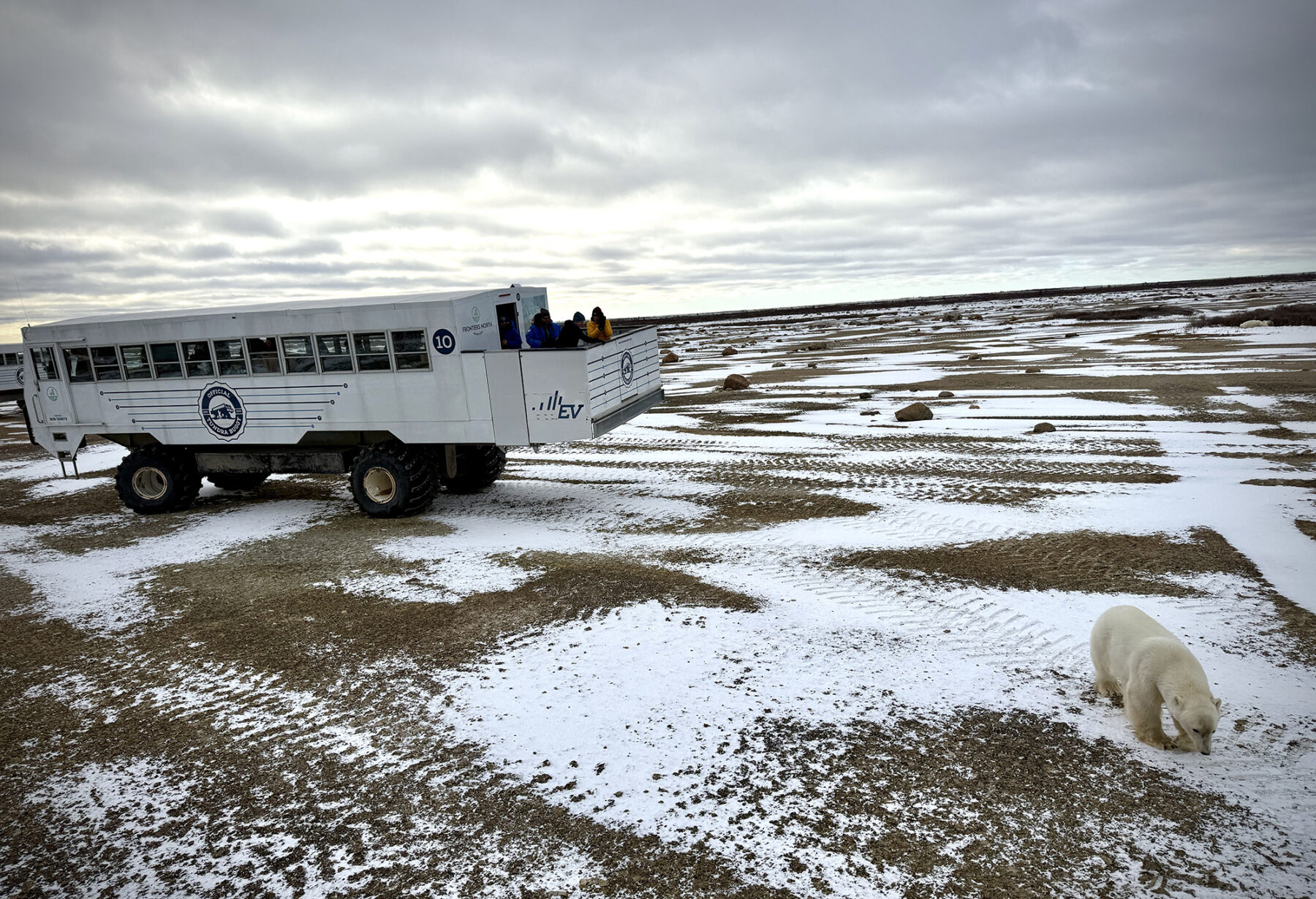
Every seat has a window and view, plus there’s an outdoor observation deck, conveniently high (of course!) and with a mesh floor and panelling around all sides with the ledge at around 4m in height – above even the highest reach of a polar bear. None of us venture out on the observation deck this evening, as visibility is dropping due to darkness falling. We content ourselves with chatting and listening to more info on bears and the region from Mark before reaching our digs for the next three nights.
The word ‘unique’ can be overused, but that’s the only word that pops into my mind to describe Tundra Buggy Lodge as the long, low ‘buildings’ I first spotted in the distance grow bigger and more defined. The lodge is, in fact, a series of connected Tundra Buggies. Two are set up as accommodation with private bunk beds (each with its own large window to spot bears passing by) and three bathrooms per buggy, along with a recreational ‘lounge’ buggy (dubbed Thanadelthur Lounge) and Dan’s Diner – yep, the restaurant – followed by another two connected buggies for staff and crew. Our Tundra Buggy is reversed into a ‘dock’ off the side of the main lodge, where it’s connected to power for recharging overnight. We trundle off, akin to departing a ship, and make our way to our bunk beds – and dinner.
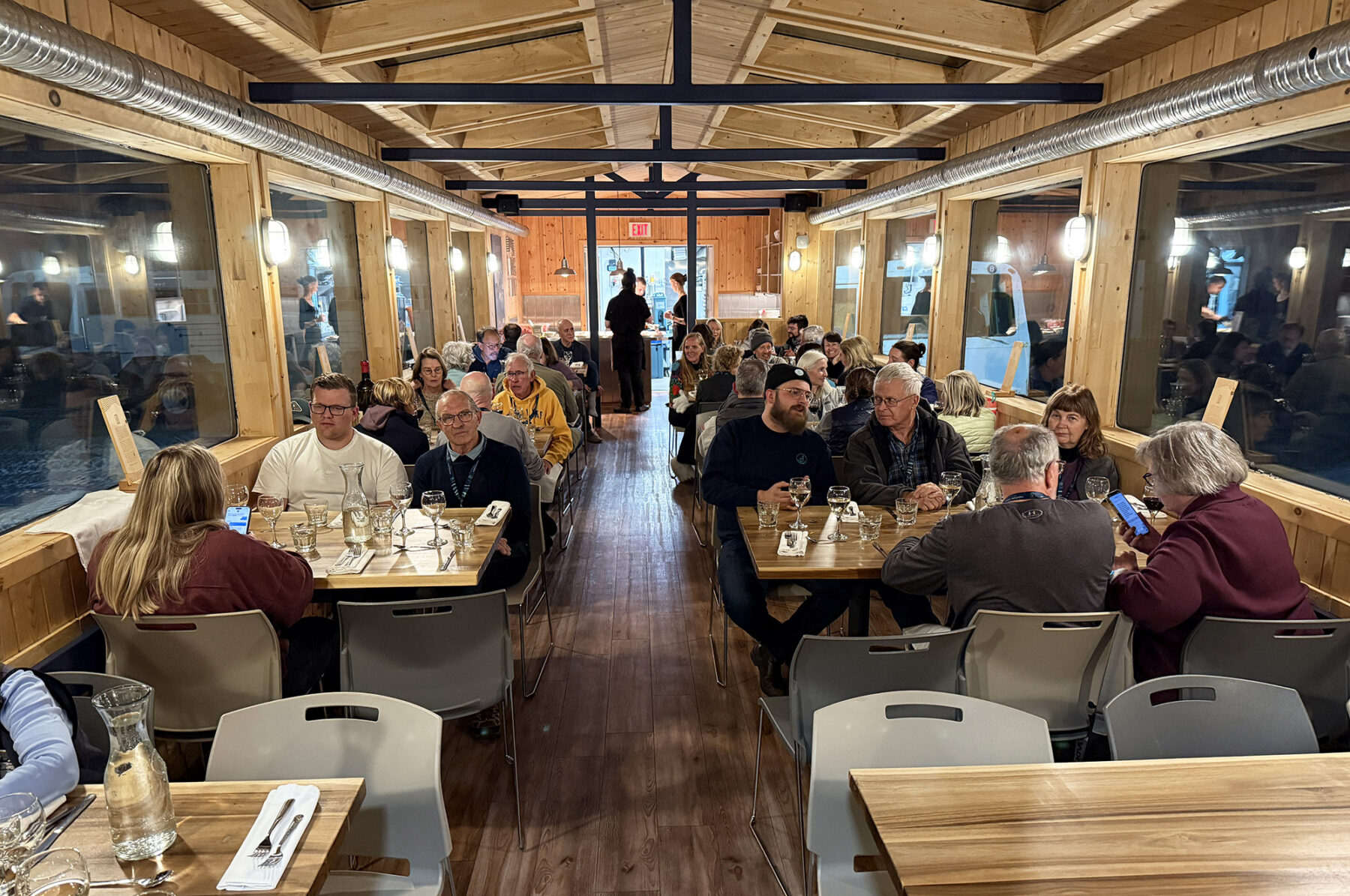
Picture yourself at 58° North in latitude, smack-bang in the middle of the subarctic tundra, with temperatures well below zero and an ever-stronger wind howling outside – all while enjoying a high-end restaurant meal experience. It’s hard to do, isn’t it? Well, I’m the same. As I sit in Dan’s Diner, chowing down on some exquisite food, I struggle to correlate the splendid meal with the ever-stronger winds outside the Tundra Buggy. It’s only our first day, and already I’m thinking that things can’t get much better.
There’s a bear out there…
Unsurprisingly, I’m quickly proven wrong: things soon get much better, and much more quickly than last night’s overtired mind could envisage. After a sumptuous breakfast at Dan’s Diner, we layer up in all our warm, windproof gear, double-check camera batteries, and board our Tundra Buggy early enough to be out on the tundra in time to catch a beautiful sunrise (the buggies from the lodge are on the tundra two hours before any town-based tour buggies arrive here). We’re overjoyed as we spot our first polar bear, only for this visual thrill to be bettered by what happens in front of us next: two adolescent males bears ‘sparring’ with each other. By sparring, I mean serious wrestling, with both bears up on their hind legs, alternating between ‘punching’ and grabbing their opponent, with plenty of mock-snarls and teeth-baring.
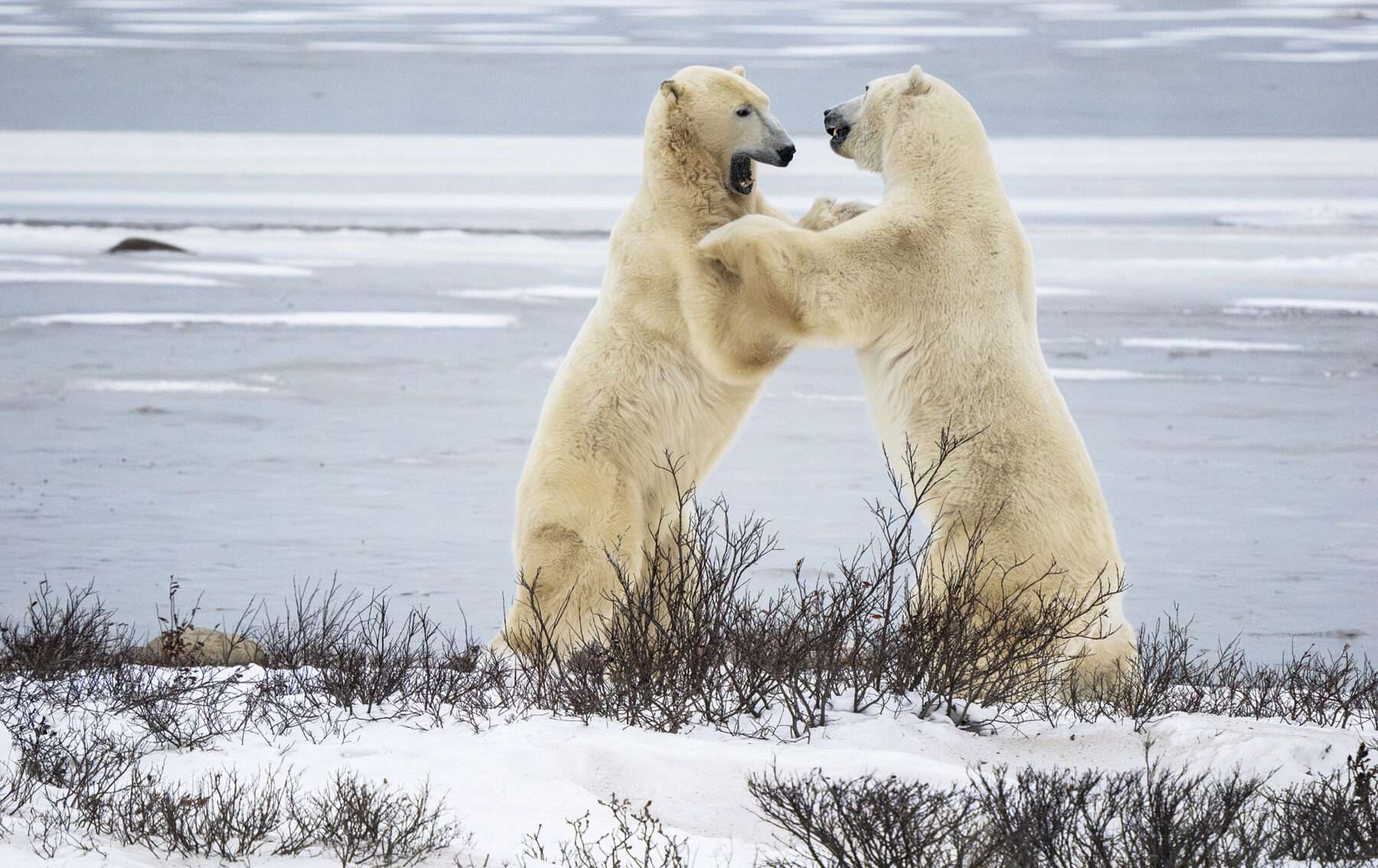
It looks – and is – spectacular, and it’s all happening no more than 15 metres from our Tundra Buggy. These two go at it with impressive speed, contradicting the slow, cuddly appearance that might spring to mind when we think ‘polar bear’. Mark explains that this behaviour is quite common (indeed, over the next three days on the tundra we see it often) and is definitely more akin to ‘play wrestling’ – but that doesn’t mean things can’t get serious, especially when cubs are involved.
A few hours after leaving the sparring bears, we spot a mother and two cubs who look to be close to the age when they leave her (around two years) – not as big as her, but still sizeable. She and the cubs are napping at their leisure as we park up nearby (the Tundra Buggies must stick to the old vehicular tracks in the CWMA – ironically, it was a former rocket range), and the scene is picture-perfect. Well, until a young male bear spots them and moves closer in. Male bears will kill (and eat) cubs if they get the chance, but this female is having none of that; she’s suddenly on full alert, her two cubs bunching in with her to present a formidably sized fur ball. The young male pauses to have a longer look at what is confronting him, and then – perhaps wisely – decides to keep on moving.
Close encounters of the tundra kind
Over the course of the next three days, we continue to be incredibly fortunate with polar bear sightings both near and far. From the overly curious female who I had the pseudo stand-off with from my lofty viewing platform perch through to an even more curious bear that spent around 40 minutes right under our feet below the outdoor viewing platform (something Mark has never seen in all his years of guiding – usually they spend barely a minute under there before getting spooked), each sighting ups the excitement levels, lifted further still by Mark and Jim’s commentary and talks. From past experiences and memorable sightings (including spotting a ‘blue’ polar bear – it had rolled in berry skins and juices for a while, staining its usually pale fur) to how quickly the ice forms in Hudson Bay at this time of year (over the three days on the tundra we see the ice moving inexorably toward the middle of the bay), the duo’s knowledge adds an extra layer to the experience. That is, along with the awesome meals at Dan’s Diner and the lunches and snacks onboard the Tundra Buggy.
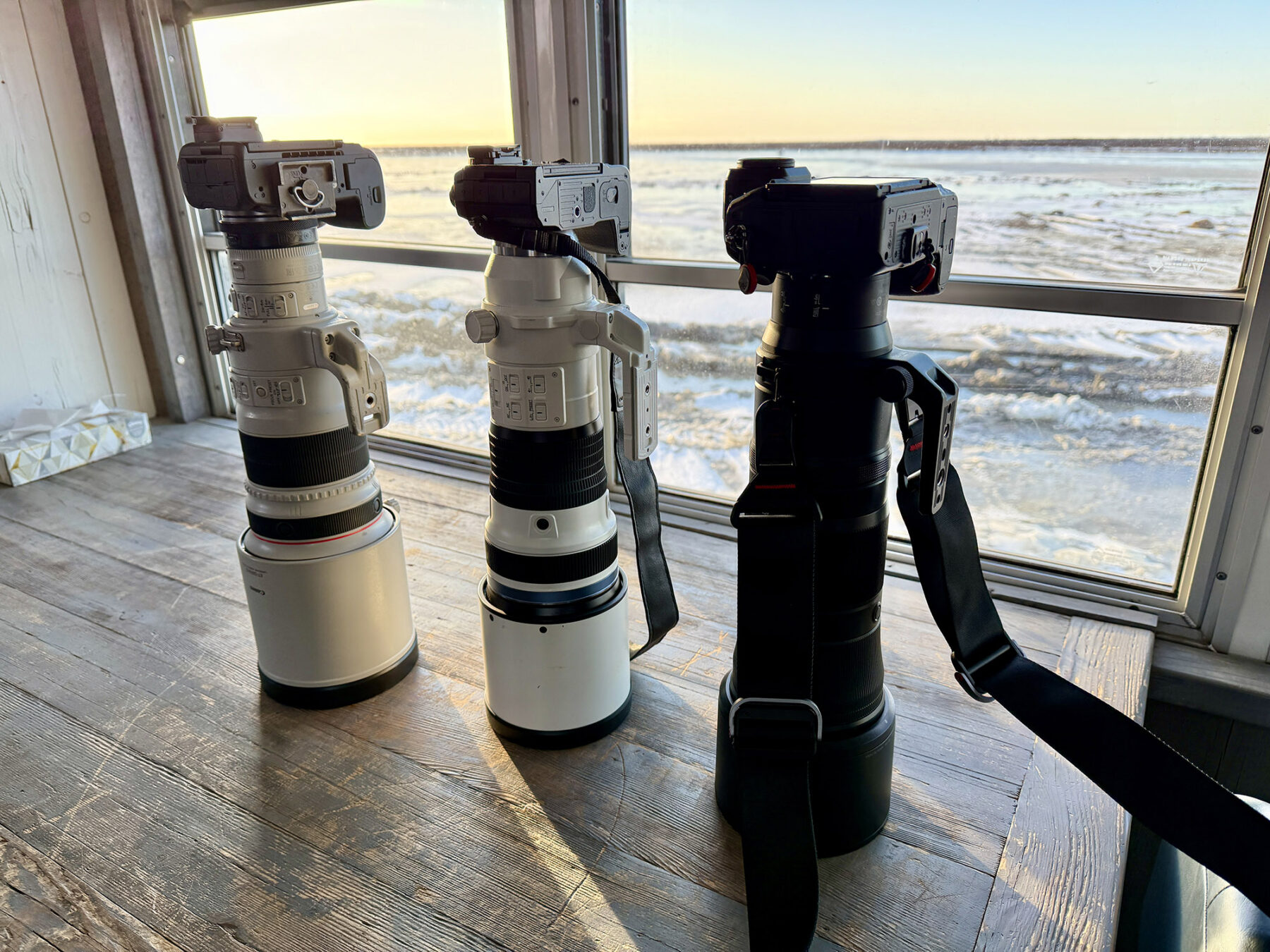
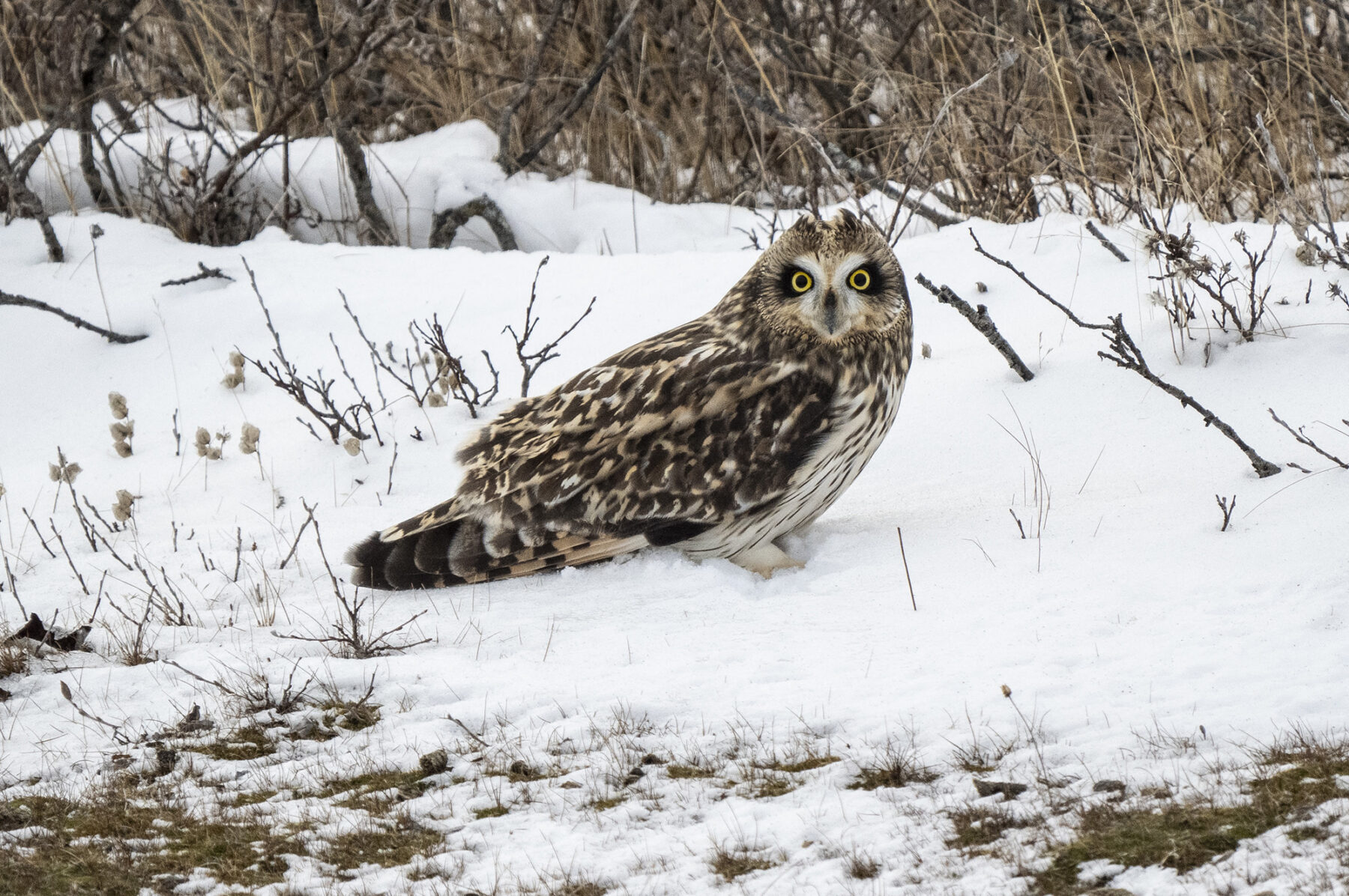
We also get timely reminders of who really rules the roost out here when one of the Tundra Buggies needs a quick repair by Skip, the lodge maintenance worker. It involves a bit of bear herding from our buggy as Skip needs to get under/beside the lodge while there are two bears close by. Jim skilfully moves our buggy slowly near them to move them away from the lodge, but the larger bear is still keen to check out what is going on. We end up playing some cat and mouse with it while Skip tries to do his work, occasionally having to run back inside to the safety of his buggy. Until we are reminded of it in scenarios such as this, it’s easy – when sitting so far above them – to forget just how perfect a hunting machine a polar bear is.
That’s something Mark explains to us in detail one day. He reminds us that the polar bear’s primary food source is the seal (it accounts for 90 per cent of the bear’s diet). A polar bear’s sense of smell is also incredibly strong; it’s now thought that polar bears can smell a seal from up to 5km away and up to a metre under the ice (the seal’s odour/smell drifts up from the breathing holes it digs for its den). That incredibly strong sense of smell is due to the bear’s nose cavity being full of turbinates (tubing) that ‘warm up’ the air it inhales, helping it to retain and promote any odours that the wind brings past.
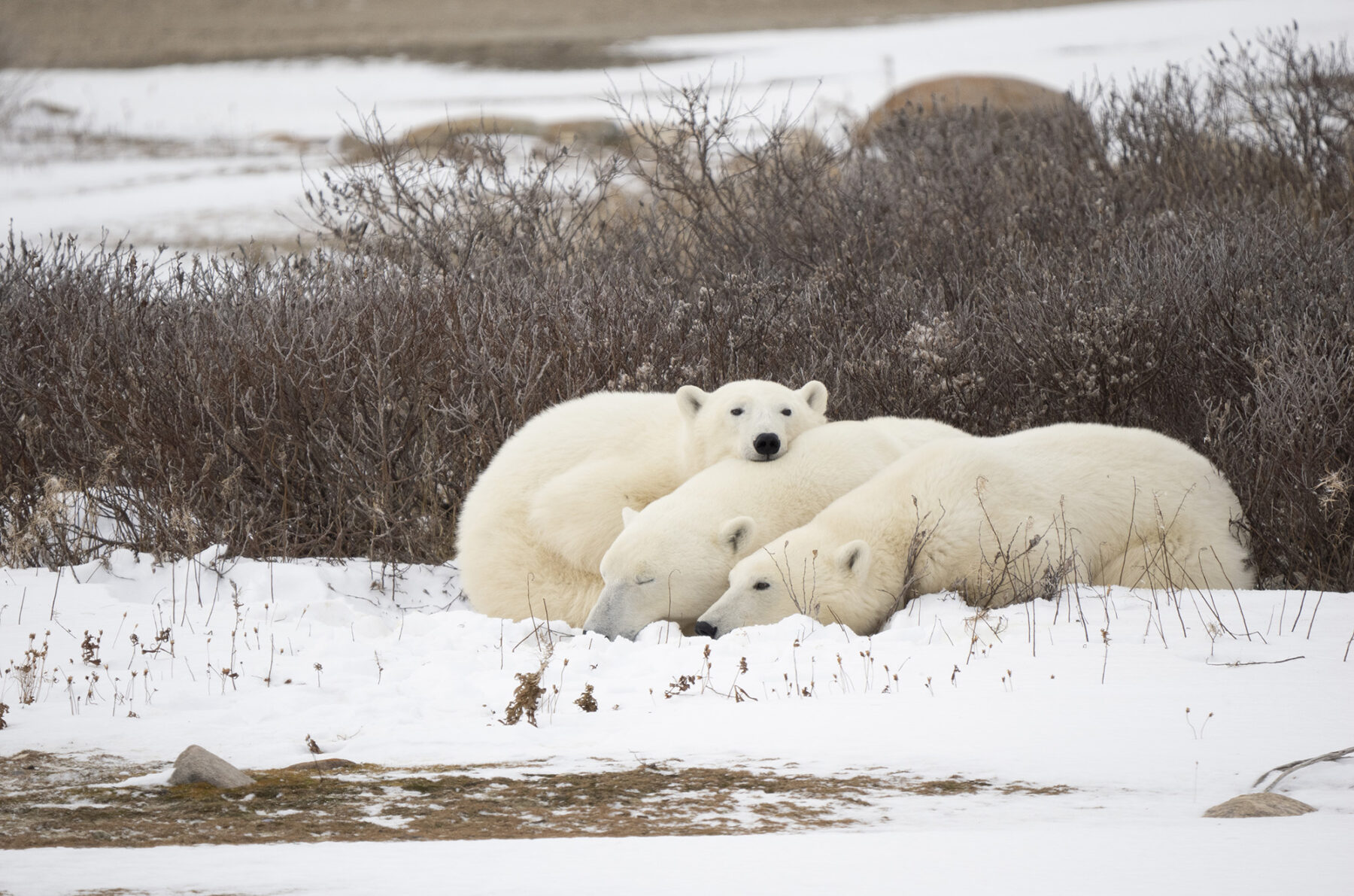
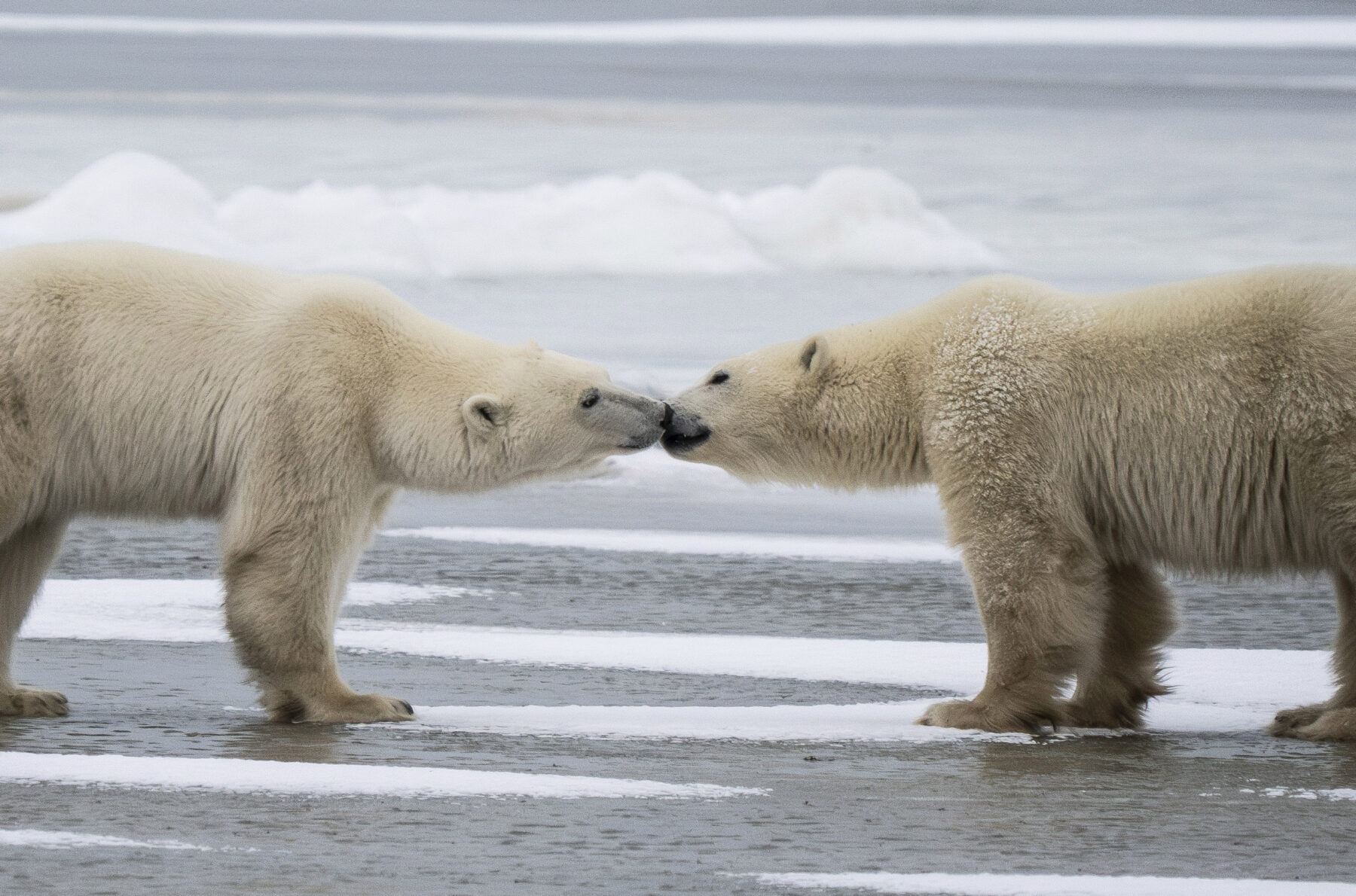
Add in a gap between its front two teeth that allows for a stronger and deeper initial bite to secure and hold the seal in place, along with one of the natural world’s most powerful jaws, and it’s easy to understand how the polar bear is so effective when hunting.
And one more, final, reminder of why they are so formidable a hunter: the reflexes of a bear have to be quick enough to react within 7/100th of a second when a seal ducks its head up and out of its breathing hole. ’Nuff said…
End of days
Our last day and a half are spent exploring more of the CWMA, ranging from inland to right on the coast where, again, we see a reminder of this incredibly wild world and how it just keeps on keeping on. The ice has expanded dramatically into the bay since our first day on the tundra, and the bears are out there, already, testing the extremities of the ice, no doubt urging it to freeze faster so they can end their long period of limited food.
Speaking of which, one bear keeps us entertained and amused for around 20 minutes as it bounces up and down on the tundra shoreline, using its front paws to break up the frozen kelp to reach the fresher stuff underneath. Mark mentions they also do this to get to lemmings, another food source. We also spot a couple of rare short-eared owls, and some pretty, pale-white ptarmigan – a smallish, pigeon-sized bird – before we leave the tundra on our last morning.
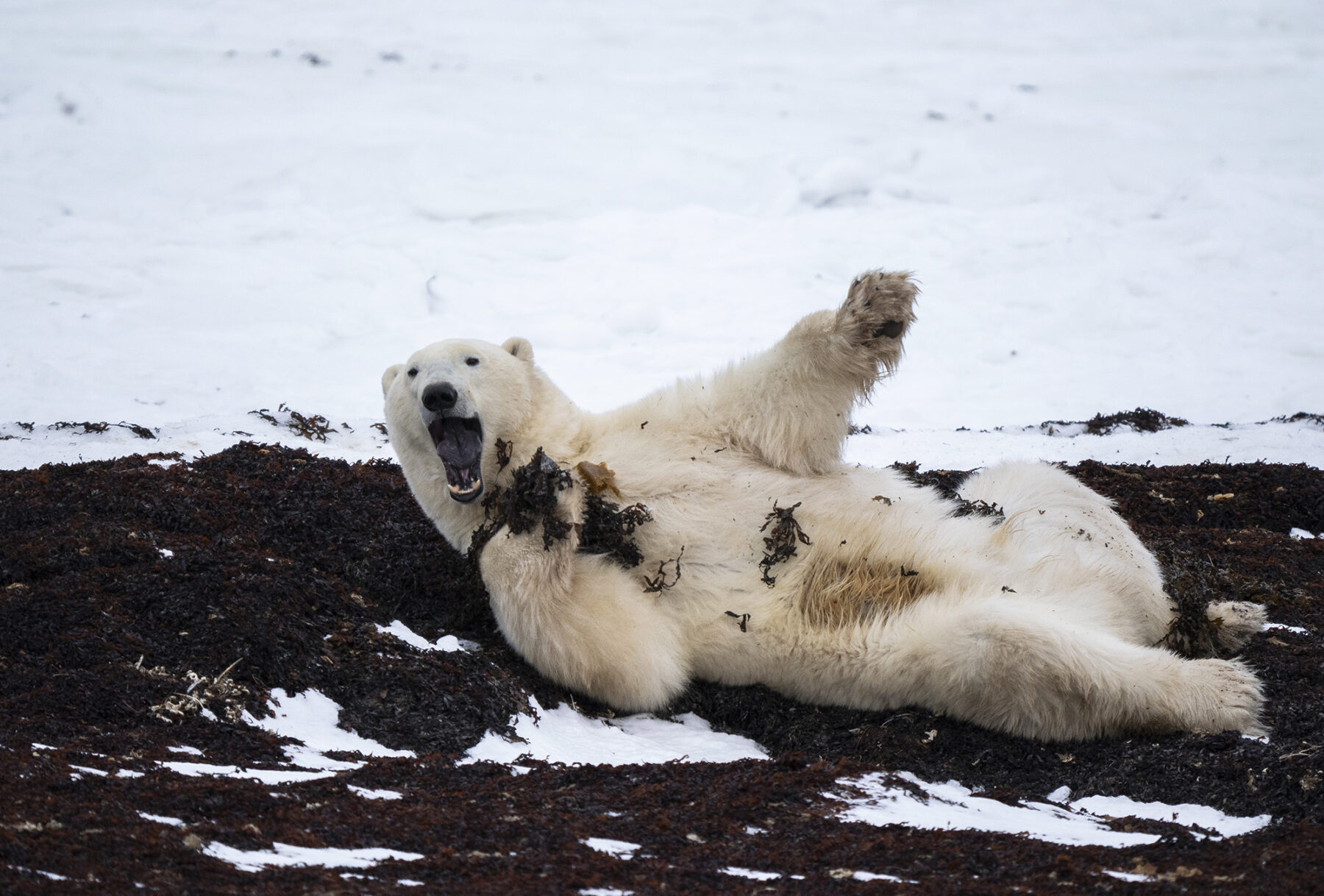
The journey back firstly to our regular bus, and then to Churchill, is a leisurely one. It’s followed by a drive and walking tour that takes in some of the town’s famous murals, which were created in 2017 as part of an art project, the brainchild of Winnipeg artist Kal Barteski, to remind the world of Churchill after it had suffered flooding that cut off the rail line, effectively isolating the town. The results are spectacular, ranging from a fully covered helicopter to the unique mural on the ‘Polar Bear Jail’.
Before heading out to Wapusk Adventures for some dog sledding, we drop in to the Parks Canada Visitor Centre, where we learn a lot more about Wapusk National Park. It was established in 1996 and is Canada’s eighth largest (and the largest contained within one province) at a massive 11,475sq.km. Inside this vastness are more than 200 species of bird and 700 species of vegetation. Eighty per cent of it is wetlands, and 7 per cent is coastal tundra. Yep, it’s impressive.
Dave Daley is an indigenous Métis man, and as well as the owner of Wapusk Adventures, he is the founder of the famous Hudson Bay Quest dog-sled race. He’s also bloody funny, as he proves when he rolls out his introductory speech and soon sets us to rights as to what is most important to him. To get to the crux of it, it’s his dogs – not his paying clients (that’d be us), whom he only puts up with because he views each of us who walk through his door as the monetary equivalent of a 20kg bag of dog-biscuits for his beloved canines. It was a simply brilliant speech and had all of us in stitches most of the way through.
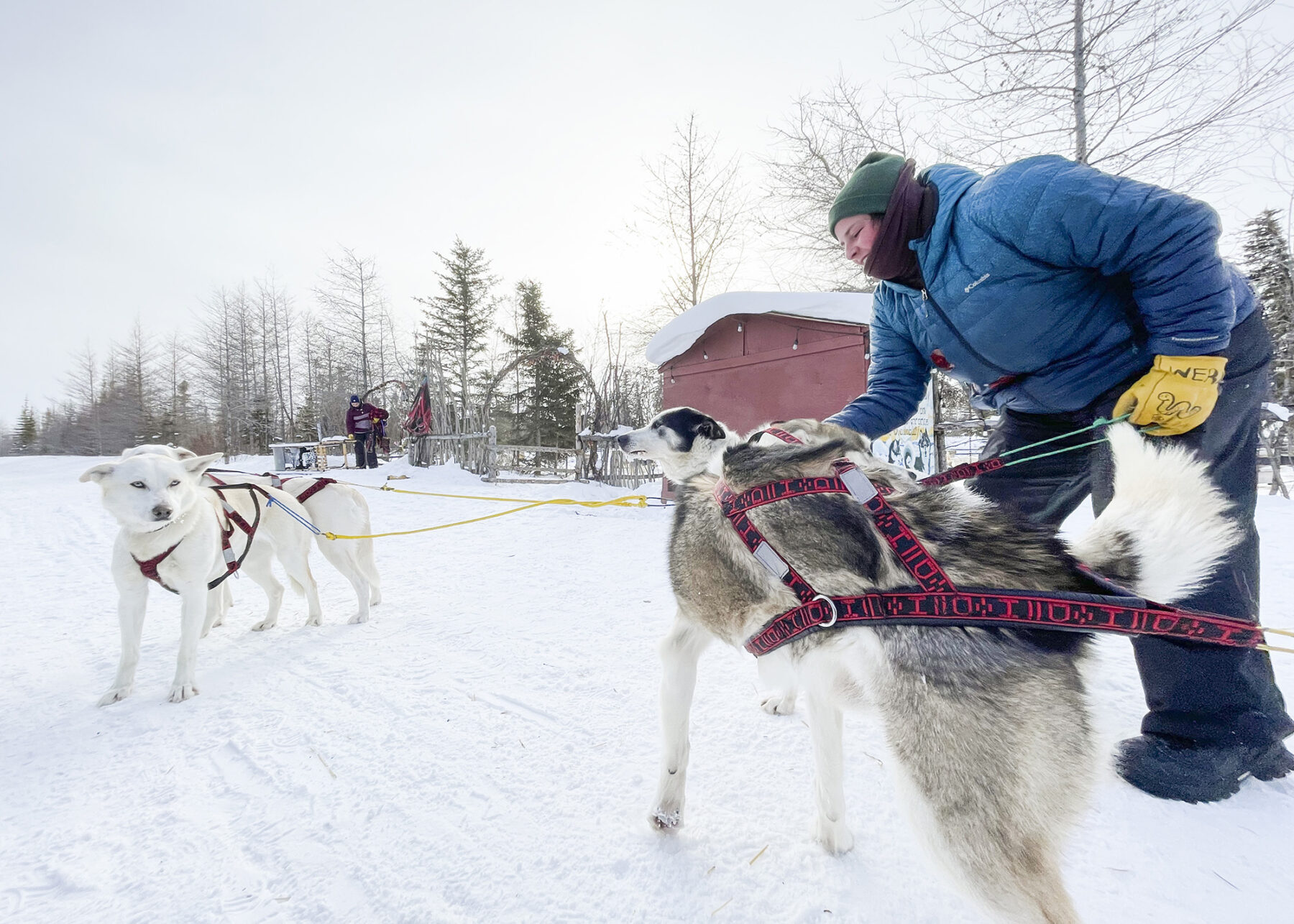
That huge sense of humour shouldn’t detract from his achievements, though, both in creating the race, racing numerous events himself, and his hard work promoting Churchill and surrounds to visitors. And the dog sledding itself? It was fast, incredibly fun, and the near-perfect way to farewell our time in Churchill.
More than one reason
For most people to whom you mention Churchill, the near-uniform answer is based around “seeing polar bears”. And I get that; it’s most definitely an unforgettable experience. But it’s not just the bears that make a visit to this far, faraway frontier town worthwhile; it’s the people, it’s the history, and it’s that incredible landscape, too. From the proud indigenous communities to the long-term local guides, the museum curators, the national park workers, the local artists and the rest of the community (and that community’s strength) – all of this, combined, is what makes a journey to this far north town so memorable. It’s a memory this visitor will never forget.
Fact file
The adventure: Frontiers North Adventures runs a number of multi-day and day trips from Churchill, ranging from summer and autumn wildlife experiences through to trips tailored for those keen to see the Northern Lights. The trip featured here is called Tundra Buggy Lodge: Town and Polar Bears.
Getting there: Air Canada offers direct flights from Sydney to Vancouver, and from there, domestic connection through to Winnipeg. Winnipeg, itself, is well worth a few days of exploring – and experiencing its excellent eateries.
VIA Rail offers a Winnipeg-Churchill train journey, which is said to be amazing.
The writer was a guest of Travel Manitoba and Frontiers North Adventures.
